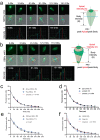Sequential roles for red blood cell binding proteins enable phased commitment to invasion for malaria parasites
- PMID: 37528099
- PMCID: PMC10393984
- DOI: 10.1038/s41467-023-40357-z
Sequential roles for red blood cell binding proteins enable phased commitment to invasion for malaria parasites
Abstract
Invasion of red blood cells (RBCs) by Plasmodium merozoites is critical to their continued survival within the host. Two major protein families, the Duffy binding-like proteins (DBPs/EBAs) and the reticulocyte binding like proteins (RBLs/RHs) have been studied extensively in P. falciparum and are hypothesized to have overlapping, but critical roles just prior to host cell entry. The zoonotic malaria parasite, P. knowlesi, has larger invasive merozoites and contains a smaller, less redundant, DBP and RBL repertoire than P. falciparum. One DBP (DBPα) and one RBL, normocyte binding protein Xa (NBPXa) are essential for invasion of human RBCs. Taking advantage of the unique biological features of P. knowlesi and iterative CRISPR-Cas9 genome editing, we determine the precise order of key invasion milestones and demonstrate distinct roles for each family. These distinct roles support a mechanism for phased commitment to invasion and can be targeted synergistically with invasion inhibitory antibodies.
© 2023. The Author(s).
Conflict of interest statement
The authors declare no competing interests.
Figures








References
-
- Ansari HR, et al. Genome-scale comparison of expanded gene families in Plasmodium ovale wallikeri and Plasmodium ovale curtisi with Plasmodium malariae and with other Plasmodium species. Int J. Parasitol. 2016;46:685–696. - PubMed
-
- Dvorak JA, Miller LH, Whitehouse WC, Shiroishi T. Invasion of erythrocytes by malaria merozoites. Science. 1975;187:748–750. - PubMed
-
- Gilson PR, Crabb BS. Morphology and kinetics of the three distinct phases of red blood cell invasion by Plasmodium falciparum merozoites. Int J. Parasitol. 2009;39:91–96. - PubMed
Publication types
MeSH terms
Substances
Grants and funding
LinkOut - more resources
Full Text Sources
Medical

